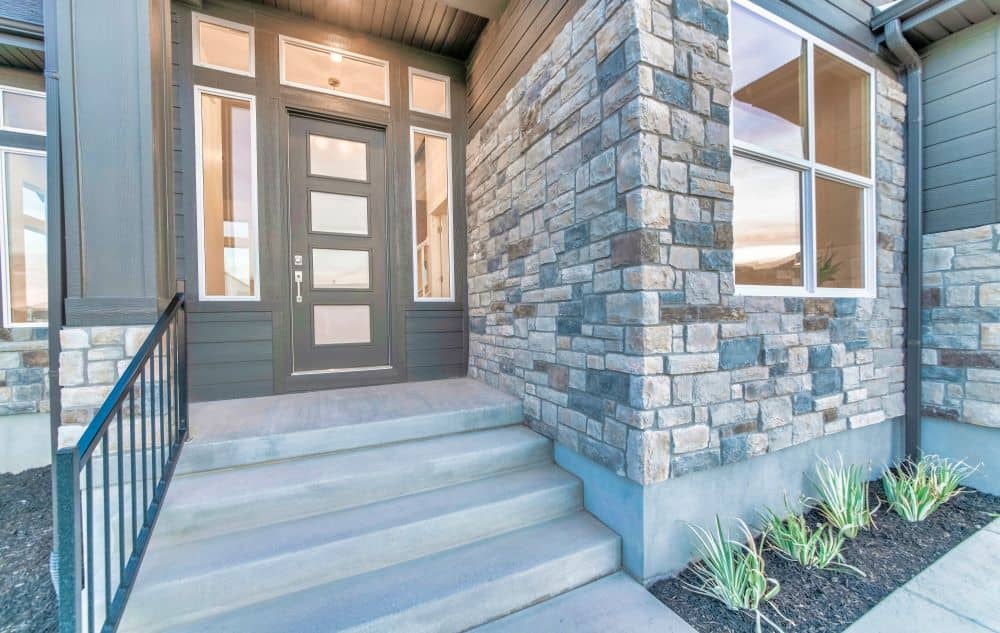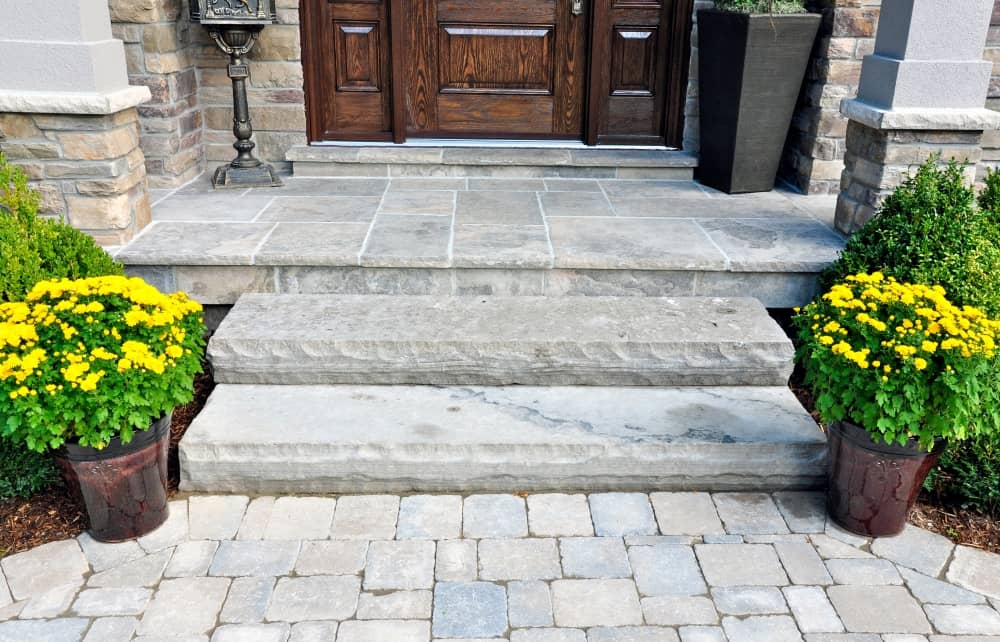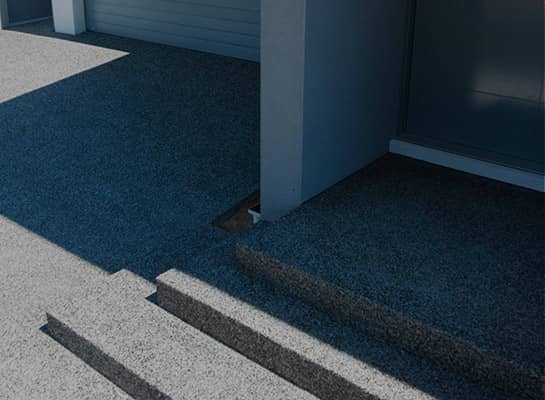6 Concrete Steps Design Ideas for Entryways and Front Porches
- November 11, 2022
- Written By Brad Russell
- Design Trends
They say you only have one chance to make a good first impression. When it comes to your house, you want the entrance to look the absolute best. After all, that’s the first thing other people tend to see. Your concrete steps are durable and reliable, but here’s the good news: they can also look great!

Before we offer ideas on how to give your concrete steps a boost in the looks department, let’s first talk about their benefits, especially when used in entryways and front porches:
- Affordable: Compared to other materials, concrete is easily one of the most budget-friendly construction solutions. That’s because concrete is made of aggregates, water, and cement, which are all inexpensive and readily available.
- Malleable: Concrete is not solid when poured, so it can be shaped using various casting and moulding. By altering the cast’s shape, you can have a straight, curved, narrow, or wide pathway.
- Curing: No need to expose poured concrete to high heat or freezing temperatures to cure and set. The material hardens at normal temperatures, meaning you can pour it in autumn or even winter, as long as it doesn’t go lower than 10 degrees Celsius (50F).
- Water-Resistant: Who wants rotten wood steps or rusty steel steps? You never have to worry about the effects of water with concrete, which will not deteriorate even when submerged underwater for some time. This is why inground pools are typically made from concrete.
- Maintenance: Minimal maintenance is required with concrete steps. Once cured and sealed, you only need to sweep to remove dust and dirt. Spraying with a garden nozzle is also a good idea from time to time. You don’t need a pressure washer unless stubborn stains are on the surface.
Another benefit of concrete steps in the entryway and front porch is that different finishing options are available. You can add personal touches, turning them into unique concrete stepping stones.
How to Make Concrete Steps Look Better
Grey concrete is timeless but can easily be enhanced for those who want a more stylish appearance. You have unlimited options, from conjuring a bit more mystique to building a zen courtyard to a natural meets modern take. Here are five design ideas that you can apply to your concrete steps on the entryway or front porch to make an inviting first impression:
1. Paint the Steps
Increase interest in your ho-hum concrete step treads with paint. Start with a solid colour, and make sure to use a concrete-sealing primer. Then apply a non-skid paint designed for concrete and high-traffic areas. Once dry, you can choose a contrasting colour, resulting in a faux stair runner.
2. Wood as an Alternative to Paint
If you’re not sold on the idea of painting your concrete steps, you can cover the unappealing steps in your front entranceway with wood instead. It’s the perfect choice for those with white steps, which may appear attractive for a while until they get soiled. Then, homeowners are forced to clean by power washing regularly to maintain the whiteness of the surface. Covering the treads with wood can help make them look brand new.
3. Add Texture
Textured concrete is more of an art and needs careful placement to avoid a haphazard look. Experienced contractors can ensure that the concrete seamlessly blends with the whole design without breaking the flow.
There are a few ways to texturise concrete steps, including using form liners explicitly designed for this purpose. They are attached to the stair form before casting concrete, as usual. It’s a complex process that is best left to the pros.
4. Use Tiles or Stones
Another way to hide worn concrete steps is to use tiles or paving stones. Most homeowners find this task relatively straightforward as it only requires tiles or stones and an adhesive. You’re free to create the pattern you desire, such as a decorative mosaic. You can also use a stencil if you have a specific design in mind. Before painting over the tiles or stones, make sure to attach them first.
5. Go Flashy
This is excellent for those with white concrete steps, which offer flexibility. Select from neon green, turquoise, bright red, or navy blue to make the front area loud. But if you truly want to be flashy, why not embellish the steps with lights? Yellow lights are perfect when used in combination with white or even dark grey concrete mixed with wood elements.
Our Recommendation: Use Exposed Aggregate
When it comes to jazzing up your new footpath, exposed aggregate for concrete is hard to beat. There are a few ways to achieve a beautiful look, including the most popular, which is to use a high-pressure spray. This method effectively blasts off the top cement surface, revealing the gorgeous aggregate. Aside from water blasters, you can also use acid and surface disruptors.
However, if you have experience laying concrete, you may be able to do the task on your own. You will need certain supplies ready, such as:
- Pebble aggregate
- Trowel
- Bucket
- Screed
- Water supply
- Garden hose
- Brush or broom with medium-hard bristles
You can also add an edging tool, a good thing to have but not required. Of course, having helpers with you will make the work easier.
The process involves mixing your concrete. We recommend mixing it onsite; alternatively, you can use premix concrete with a standard cure time. You then have to box the area, pour the mixed concrete, lay and screed, and finally, trowel until smooth.
The job is not finished, as you have to scatter or sprinkle the pebbles onto the surface. Make sure the concrete is firm but not too firm – just enough to hold the stones; otherwise, they will sink out of sight. Use a trowel to push down the pebbles into the concrete with consistent pressure. Take care not to create dents, which can appear if you push down too hard. An edging tool can give the path a nice edge.
Wait for about eight hours or so until the concrete is firm. Then, you can begin exposing the aggregate using a brush or broom and water. This technique will wash away the first layer of the cement, exposing the pebbles.
This DIY method indeed takes time and a whole lot of effort. If you want the best outcome, hire professionals. The DCWA team created a beautiful combination of the exposed aggregate driveway, steps, and entryway in Doubleview. Check the incredible result here.
Pouring concrete and designing it on your own is certainly doable. However, things can go wrong, especially if you don’t know what you’re doing. These tasks require careful planning, skills, and knowledge, as well as the right tools, equipment, and materials. Let our professionals pour, fix, replace, and beautify your old, cracked concrete steps in the entryway and front porch. Contact Decorative Concrete WA today!


